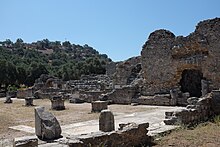Iasos
Ἰασός or Ἰασσός (in Greek) | |
 The hill with the acropolis, the bouleuterion (center) and a Hellenistic tower (right) near the agora of Iasos. | |
| Alternative name | Iassos |
|---|---|
| Location | Kıyıkışlacık, Muğla Province, Turkey |
| Region | Caria |
| Coordinates | 37°16′40″N 27°35′11″E / 37.27778°N 27.58639°E |
| Type | Settlement |
Iasos or Iassos (
History





Ancient historians consider Iasos a
Iasos was a member of the
The mountains in the neighbourhood of Iasus furnished a beautiful kind of marble, of a blood-red and livid white colour, which was used by the ancients for ornamental purposes.[6] Near the town was a sanctuary of Hestia, with a statue of the goddess, which, though standing in the open air, was believed never to be touched by the rain.[7] The same story is related, by Strabo, of a temple of Artemis in the same neighbourhood. Iasus, as a celebrated fishing place, is alluded to by Athenaeus.[8] The place is still existing, under the name of Askem or Asýn Kalessi. Chandler (Travels in As. Min. p. 226) relates that the island on which the town was built is now united to the mainland by a small isthmus. Part of the city walls still exist, and are of a regular, solid, and handsome structure. In the side of the rock a theatre with many rows of seats still remains, and several inscriptions and coins have been found there.
It seems to have been abandoned in about the 15th–16th century, in the
Archaeology
Preliminary research was done by the French archaeologist Charles Texier in 1835. A number of ancient Greek inscriptions were removed from the site which were later donated to the British Museum by the Duke of St Albans.[9] Since then, Iasos and the necropolis have been under regular scientific excavations on behalf of the Italian School of Archaeology at Athens by Doro Levi (1960–1972), Clelia Laviosa (1972–1984) and Fede Berti (1984–2011). From 2011 till 2013 the Director of Iasos excavations has been Marcello Spanu .
The site of Iasos has been settled continuously since the
During the 1970s, archaeological excavations at Iasus revealed Mycenean buildings (with two "Minoan" levels underneath them).
"At Iasus, Mycenaean buildings, approximately dated by the presence of LH IIIa ware, have been found below the protogeometric cemetery. Below this again two 'Minoan' levels are reported, the earlier containing local imitations of MM II-LM I ware, the later imported pieces of the Second Palace Period (AJA [1973], 177-8). Middle and Late Minoan ware has also occurred at Cnidus (AJA [1978], 321)."[10]
Other archaeological finds cover
Outstanding remains in Iasos include an Artemis stoa and Roman villas.
Church history
Four of its bishops are known: Themistius in 421, Flacillus in 451, David in 787, and Gregory in 878 (
Iasus is listed among the titular sees of Caria in the Annuario Pontificio.[11] The titular see has had the following[12][13] [14] Bishops:
- Bishop Salvador Martinez Silva (1940.08.10 – 1969.02.07)[15][16]
- Bishop Antonio Laubitz (1924.11.08 – 1939.05.17)
- Bishop Gregorio Ignazio Romero (1899.06.19 – 1915.02.21)
- Bishop John Joseph Keane (later Archbishop) (1888.08.12 – 1897.01.29)
- Bishop Gaetano d'Alessandro (later Archbishop) (1884.03.24 – 1888.03.18)
- Bishop Étienne-Louis Charbonnaux, M.E.P. (1844.07.08 – 1873.06.23)
- Bishop Ernst Maria Ferdinand von Bissingen-Nieppenburg (1801.12.23 – 1820.03.12)
- Bishop Emanuel Maria Graf Thun (1797.07.24 – 1800.08.11)
- Bishop-elect Bartolome Gascon (1727.03.17 – ?)
Gallery
-
Iasos Agora
-
Iasos Agora Frieze
-
Iasos Agora Frieze
-
Iasos Agora Plan
-
Iasos Agora Bouleuterion
-
Iasos Agora Bouleuterion
-
Iasos Agora Basilica
-
Iasos at agora Necropolis
-
Iasos at agora Zeus Megistos area
-
Iasos museum Altars
-
Iasos museum Altar detail
-
Iasos museum Altar detail
-
Iasos museum Altar
-
Iasos museum Treaty
-
Iasos museum Capital
-
Iasos museum Frieze
-
Iasos museum
-
Iasos museum
See also
Notes
- ^ Thucydides VIII:28, Polybius XVI:12, XVII:2, Livy XXIII:30
- ^ Polybius. Historiae, xvi. 12.
- ^ Thucydides. History of the Peloponnesian War, viii. 28.
- Geographia, xiv.
- .
- ^ Paul the Silentiary. Description of Hagia Sophia, ii. 213.
- ^ Livy. The History of Rome, [1].
- ^ Athenaeus. Deipnosophistae, iii., xiii.
- ^ British Museum Collection
- ^ Mitchell, S.; McNicoll, A. W. (1978–1979). "Archaeology in Western and Southern Asia Minor 1971–78". Archaeological Reports (25): 59–90.
- ISBN 978-88-209-9070-1), p. 911
- ^ Pius Bonifacius Gams, Series episcoporum Ecclesiae Catholicae, Leipzig 1931, p. 448.
- ^ Michel Le Quien, Oriens christianus in quatuor Patriarchatus digestus, Parigi 1740, Tomo I, coll. 913-914.
- ^ Konrad Eubel, Hierarchia Catholica Medii Aevi, vol. 5, p. 226; vol. 6, p. 241.
- ^ David M. Cheney, Iasos at catholic-hierarchy.org.
- ^ Iasos, at GCatholic.org.
References
- Herbermann, Charles, ed. (1913). . Catholic Encyclopedia. New York: Robert Appleton Company.
- Grande Encyclopédie, s.v. Iasos 20:505.
- Fede Berti, Roberta Fabiani, Zeynep Kızıltan, Massimo Nafissi (ed.), Marmi erranti. I marmi di Iasos presso i musei archeologici di Istanbul. Gezgin Taşlar. Istanbul Arkeoloji Müzeleri'ndeki Iasos Mermerleri. Wandering marbles. Marbles of Iasos at the Istanbul Archaeological Museums. (Istanbul Arkeoloji Müzeleri 7.12.2010 – 4.7.2011). Istanbul: Istanbul Arkeoloji Müzeleri Müdürlüğü, 2010.



















